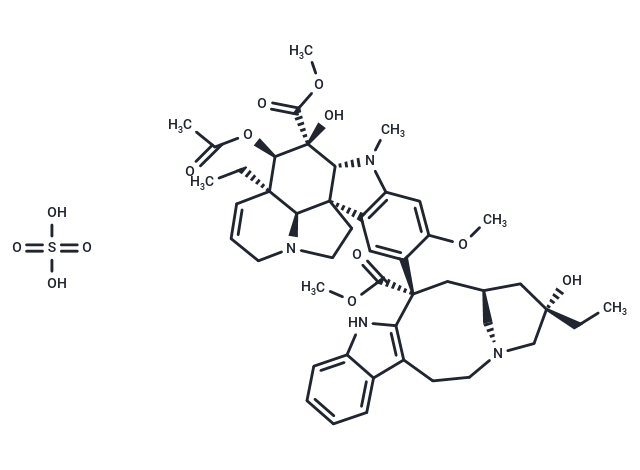Shopping Cart
Remove All Your shopping cart is currently empty
Your shopping cart is currently empty
Vinblastine sulfate (Vincaleukoblastine sulfate salt) can inhibit the formation of microtubule, it also inhibits nAChR(IC50=8.9 uM).

| Pack Size | Price | USA Warehouse | Global Warehouse | Quantity |
|---|---|---|---|---|
| 5 mg | $50 | In Stock | In Stock | |
| 10 mg | $54 | In Stock | In Stock | |
| 25 mg | $64 | In Stock | In Stock | |
| 50 mg | $84 | In Stock | In Stock | |
| 100 mg | $97 | In Stock | In Stock | |
| 1 mL x 10 mM (in DMSO) | $63 | In Stock | In Stock |
| Description | Vinblastine sulfate (Vincaleukoblastine sulfate salt) can inhibit the formation of microtubule, it also inhibits nAChR(IC50=8.9 uM). |
| Targets&IC50 | nAChR:8.9 μM |
| In vitro | The average terminal half-lives of Vinblastine is 14.3 h. When incubated in freshly isolated rat hepatocytes, VLB penetrates rapidly and intensely into the cells, probably through a passive diffusion mechanism followed by tight cellular binding[3]. Vinblastine inhibits the angiogenic response induced by adrenomedullin and is also positive for mitotic slippage, causing micronuclei in mononucleate cells with cytokinesis block[4]. vinblastine gives significant increase in micronucleated mononucleated cells at concentrations that produced approximately 50% cell death and cytostasis or less as calculated using RPD, RICC and RCC[2]. |
| In vivo | Vinblastine, a widely used anticancer drug, has undesired side effects [6]. A combination of VBL and RAP at very low doses achieves a satisfactory antiangiogenic effect against human HCC in vivo [4]. The clinically relevant dose of vinblastine inhibits tubulin palmitoylation in CEM cells (effect on depalmitoylation of tubulin) in vivo [5]. |
| Kinase Assay | Cell based receptor autophosphorylation assays: Autophosphorylation of PDGFR family kinase assays are cell-based enzyme-linked immunosorbent (ELISA) assays using CHO cells expressing wild-type PDGFRβ, chimeric protein PDGFRβ/c-Kit, and PDGFRβ/Flt3 which contain the extracellular and transmembrane domains of PDGFRβ and the cytoplasmic domain of c-Kit, and Flt-3. Cells are grown to confluency in 96-well microtiter plates under standard tissue culture conditions, followed by serum starvation for 16 hours. Briefly, quiescent cells are incubated at 37 °C with increasing concentrations of Tandutinib for 30 minutes followed by the addition of 8 nM PDGF-BB for 10 minutes. Cells are lysed in 100 mM Tris, pH 7.5, 750 mM NaCl, 0.5% Triton X-100, 10 mM sodium pyrophosphate, 50 mM NaF, 10 μg/mL aprotinin, 10 μg/mL leupeptin, 1 mM phenylmethylsulfonyl fluoride, 1 mM sodium vanadate, and the lysate is cleared by centrifugation at 15,000 g for 5 minutes. Clarified lysates are transferred into a second microtiter plate in which the wells are previously coated with 500 ng/well of 1B5B11 anti-PDGFRβ mAb and then incubated for 2 hours at room temperature. After washing three times with binding buffer (0.3% gelatin, 25 mM HEPES, pH 7.5, 100 mM NaCl, 0.01% Tween 20), 250 ng/mL of rabbit polyclonal anti-phosphotyrosine antibody is added and plates are incubated at 37 °C for 60 minutes. Subsequently, each well is washed three times with binding buffer and incubated with 1 μg/mL of horseradish peroxidase-conjugated anti-rabbit antibody at 37 °C for 60 minutes. Wells are washed prior to adding 2,2'-azino-bis(3-ethylbenzthiazoline-6-sulfonic acid), and the rate of substrate formation is monitored at 650 nm. |
| Cell Research | Six-well treatment plates are set up that contained 5 × 104 cells/mL in each well, suspended in 3 mL culture medium, and these are treated with vinblastine for 3 h followed by 21 h growth. (Only for Reference) |
| Synonyms | Vincaleukoblastine sulfate salt, NSC49842 |
| Molecular Weight | 909.06 |
| Formula | C46H58N4O9·H2SO4 |
| Cas No. | 143-67-9 |
| Smiles | OS(O)(=O)=O.CC[C@]1(O)C[C@H]2C[N@](C1)CCc1c([nH]c3ccccc13)[C@@](C2)(C(=O)OC)c1cc2c(cc1OC)N(C)[C@@H]1[C@]22CCN3CC=C[C@](CC)([C@@H]23)[C@@H](OC(C)=O)[C@]1(O)C(=O)OC |
| Relative Density. | 1.37 g/cm3 |
| Color | White |
| Appearance | Solid |
| Storage | keep away from moisture | Powder: -20°C for 3 years | In solvent: -80°C for 1 year | Shipping with blue ice/Shipping at ambient temperature. | |||||||||||||||||||||||||||||||||||
| Solubility Information | DMSO: 242 mg/mL (266.21 mM), Sonication is recommended. Ethanol: < 1 mg/mL (insoluble or slightly soluble) | |||||||||||||||||||||||||||||||||||
| In Vivo Formulation | 10% DMSO+40% PEG300+5% Tween 80+45% Saline: 5 mg/mL (5.5 mM), Sonication is recommended. Please add the solvents sequentially, clarifying the solution as much as possible before adding the next one. Dissolve by heating and/or sonication if necessary. Working solution is recommended to be prepared and used immediately. The formulation provided above is for reference purposes only. In vivo formulations may vary and should be modified based on specific experimental conditions. | |||||||||||||||||||||||||||||||||||
Solution Preparation Table | ||||||||||||||||||||||||||||||||||||
DMSO
| ||||||||||||||||||||||||||||||||||||
| Size | Quantity | Unit Price | Amount | Operation |
|---|

Copyright © 2015-2025 TargetMol Chemicals Inc. All Rights Reserved.